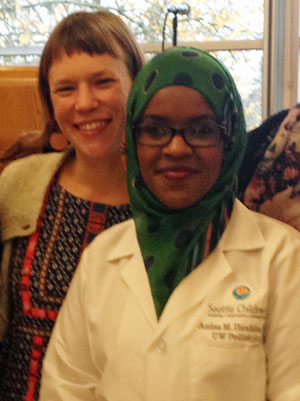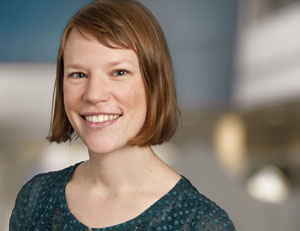
Dr. Anisa Ibrahim was 6 in 1993 when her family came to Seattle from Somalia, driven from their country by civil war. In the beginning, everything about their new country was exciting and confusing — especially the supermarket.
“We were used to going to the market every day to buy fresh food,” recalls Ibrahim, now a third-year resident in pediatrics at Seattle Children’s. “It was hard to transition to buying bags and boxes of food in bulk.”
Foods the family relied on back home — like goat and guava — were not readily available. And snacks Ibrahim’s classmates pulled out of their lunchboxes — like cheese and Chex mix — were completely unfamiliar.
Unlike some refugees, Ibrahim and her siblings were healthy and well-nourished when they arrived. And thanks to her mom’s skill at cooking and adaptation, says Ibrahim, they stayed that way as they learned their way around the new food landscape.
As a doctor, Ibrahim wants to ensure other families can do the same. That’s why she carved out time during residency to work with Dr. Beth Dawson-Hahn, a pediatrician and research fellow in the Center for Child Health, Behavior and Development at Seattle Children’s Research Institute, who is studying refugee children and nutrition.
Before, during and after
Between 2,000 and 3,000 refugees settle in Washington every year, and nearly half of them are under the age of 20. Dawson-Hahn, who has worked with refugees in the U.S., Haiti and Kenya, wants to learn more about these children from a nutritional standpoint so policymakers and healthcare providers can design targeted strategies to help them stay healthy in the long run.
Working with community partners (including public health officials, refugee agencies, HealthPoint Community Health Centers and others) Dawson-Hahn is approaching the issue from three directions:
- Before immigrating: What is the nutritional status of child refugees before they arrive in Washington, and how does it compare to children already living in the state?
- During the transition: What’s the best way to teach refugee families about buying and preparing healthy foods for their kids?
- After settling in: How do the nutritional needs of refugee children change as they acclimate to their new environment?
Dawson-Hahn’s work is supported, in part, by the Center for Diversity and Health Equity at Children’s.
Getting to know you…before you arrive
“For a long time, people have assumed that under-nutrition and wasting are the only nutritional issues that affect refugee children,” says Dawson-Hahn. “But with the prevalence of obesity increasing worldwide, we wondered if they were affected by underweight and overweight.”
Working with the Refugee Health Program at the Washington State Department of Health (DOH), Dawson-Hahn accessed and analyzed height and weight data recorded by the U.S. government during overseas medical exams for children who resettled in Washington between 2012 and 2014.
“We found that nearly one half of all refugee children had at least one form of malnutrition, and there was, as we suspected, a double burden of underweight and overweight,” says Dawson-Hahn.

Dawson-Hahn and her co-authors also used publicly available data to compare the nutritional status of refugee children to other low-income children in Washington.
“Refugee families are often a low-income group when they arrive, but they don’t necessarily match the profile of other low-income children in Washington when it comes to nutritional status,” she says. The study, published in January, found that refugee children were much more likely to be undernourished before arrival and their Washington peers more likely to be obese.
The data will help healthcare providers understand how refugee children are alike and different from each other — and from the other children they care for.
“Our results will help create a brief about refugee children from different areas, which will be instructive for healthcare providers and nutrition programs, like WIC, that serve refugee families,” she says. “In a busy clinic, it’s easy to lump all refugees together, not necessarily knowing that Iraqi children might be more likely to be overweight than children from Burma, for example.”
Making new foods familiar
Dawson-Hahn was also a driving force behind First Foods, which brought together refugee and immigrant parents of children under the age of 2 for conversation and education about nutrition and positive parenting. Classes were taught in five languages: Arabic, Burmese, Dari (spoken in Afghanistan), Nepali and Somali.
Over the course of five sessions, the caregivers (mostly moms) learned to prepare healthy foods that they might not have seen or tried before, and they learned where to find familiar foods from home.
“The parents loved learning how to prepare the same food in different ways,” says Ibrahim, who was one of Dawson-Hahn’s partners in developing the course. “For instance, you can puree apples into applesauce for an infant or slice them up for snacks for a toddler. But you don’t necessarily know that unless someone shows you.”
The classes also gave parents a chance to share details about their lives, including the foods they treasure and the challenges they face.
Identifying risks down the road
Finally, Dawson-Hahn is studying how the nutritional status of refugee children changes as they acclimate to their new environments to understand whether certain groups are at risk for obesity or other nutrition-related issues.
Dawson-Hahn’s approach is unique, says Jasmine Matheson, manager of the Refugee Health Program for Washington DOH and a frequent collaborator. “Using existing data sources to describe this population sounds simple, but it hasn’t routinely been done,” she says. “She’s bringing new ideas to the table and finding evidence that will help healthcare providers, policymakers and service providers better understand the needs of refugee children.”
Ibrahim, who just left Seattle for a rotation in Kenya as part of the residency program’s global health pathway, says working with Dawson-Hahn grounded her in a type of research that she hopes to continue when she graduates from the residency program and starts work at Harborview Pediatric Clinics, where she has practiced throughout her residency and where the two first met.
The job will bring her full circle. “I grew up in that clinic — from the time I came to America until I was too old to go there,” she says. “I don’t even have a word to describe how amazing it is that I will be working there.”
Resources
- Dr. Beth Dawson-Hahn, Seattle Children’s
- PLOS One: Comparison of the Nutritional Status of Overseas Refugee Children with Low Income Children in Washington State

